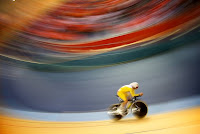Post-Workout Bicarbonate (NaHCO3) Buffers Performance Decline on 2nd Bout of Exhaustive Exercise by 62%!
 |
| AM/PM cyclists rejoice: Bicarbonate is going to get you back into the saddle. |
Exactly that, however, is what scientists from the "Department of Sport and Physical Activity" at the Edge Hill University and the "Department of Life Sciences" at the University of Derby (Gough 2017).
You can learn more about bicarbonate and pH-buffers at the SuppVersity
In a counterbalanced, crossover design, nine healthy and active males (age: 23±2 years, height: 179±5 cm, body mass: 74±9 kg, peak mean minute power (WPEAK) 256±45 W, peak oxygen uptake (VO2PEAK) 46±8 ml/kg/min) performed a graded incremental exercise test, two familiarisation and two experimental trials.
"Using a double blind approach, 30 min into a 90 min recovery period participants ingested either 0.3 g.kg-1 body mass sodium bicarbonate (NaHCO3) or a placebo (PLA) containing 0.1 g/kg body mass sodium chloride (NaCl) mixed with 4 ml/kg tap water and 1 ml/kg orange squash 30 to 35 min into a 90 min passive recovery period. Treatments were administered double blind, with trials counterbalanced. " (Gough 2017).When they analyzed the data from the first and second cycling session, the scientists found that the mean differences between TLIM2 and TLIM1 were larger for PLA compared to NaHCO3 (-53±53 vs. -20±48 s; P=0.008, d=0.7, CI=-0.3, 1.6).
Was it gastrointestinal distress? I can't tell because correlation data isn't available for that either. What I can tell you, though, is that there was a main effect for time observed for abdominal discomfort (AD) following NaHCO3 (P=0.008), whereby AD was greater at 60 (z=2.032, P=0.042) and 90 min (z=2.232, P=0.026) compared to 30 min recovery. No differences in AD were observed between NaHCO3 and PLA at 30 (median NaHCO3=0 vs. PLA=0; z=-0.333, P=0.739), 60 (0 vs. 1; z=0.318, P=0.750) or 90 min (0 vs. 2; z=1.186, P=0.236) of recovery between treatments. Gut fullness wasn't affected by either treatment, but some subjects obviously thought that a bowel movement was approaching 60 or 90 minutes into the recovery on bicarb.
 |
| The Latest on Sodium Bicarbonate: Serial Loading Almost as Effective as Acute Loading | more |
Now, this doesn't mean that you shouldn't try bicarbonate pre- or post-workout loading (the latter only if you have to work out twice within a few hours), but it does mean that you don't have to freak out if your tummy doesn't like bicarbonate ingestions (don't forget to try Serial Loading before giving up, though) | Comment on Facebook!
- Carr, Amelia J., Will G. Hopkins, and Christopher J. Gore. "Effects of acute alkalosis and acidosis on performance." Sports medicine 41.10 (2011): 801-814.
- Gough, Lewis A., et al. "Ingestion of Sodium Bicarbonate (NaHCO3) Following a Fatiguing Bout of Exercise Accelerates Post-Exercise Acid-Base Balance Recovery and Improves Subsequent High-Intensity Cycling Time to Exhaustion." International Journal of Sport Nutrition and Exercise Metabolism (2017): 1-25.










